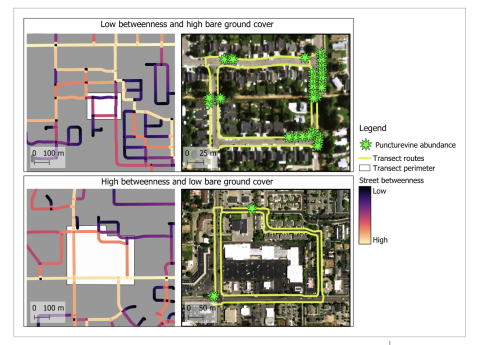- Urban landscapes often harbour organisms that harm people and threaten native biodiversity. These landscapes are characterized by differences in socioeconomic context, habitat suitability and patch connectedness. Identifying which spatial differences enable outbreaks of pests, pathogens and invasive species will improve targeted control efforts.
- We tested hypotheses to explain the distribution and demography of puncturevine Tribulus terrestris, a human-dispersed invasive plant in Boise, a city in the western United States. We hypothesized an increase in puncturevine infestations near low-valued properties with a high proportion of bare ground, the species' preferred microhabitat, that are well connected on the urban road network. To test these hypotheses, we collected data on the abundance, emergence and persistence of reproductive plants in transects spanning >100 km of our study city. We then used hierarchical Bayesian models to evaluate the impacts of spatial covariates on puncturevine distribution and demography.
- Bare ground cover consistently increased abundance, emergence and persistence of puncturevine, indicating the overarching importance of suitable establishment sites for this invasive species.
- Property value had the strongest impact on puncturevine abundance and was the most important main effect in the model for puncturevine emergence. In both models, lower-valued properties had a higher risk of puncturevine occurrence.
- The effects of road network connectivity depended on bare ground cover, with the highest predicted abundance and emergence of puncturevine in patches with low connectivity on the road network and high bare ground cover. Understanding these relationships will require data that can disentangle seed dispersal from establishment limitations.
- Identifying characteristics of urban patches that promote outbreaks of harmful species will improve the effectiveness and equity of control efforts. The prevalence of puncturevine in lower-valued properties is cause for concern as the plant impedes bicycle transportation, with the potential for disproportionate impacts on marginalized groups that lack resources to repair punctured tires. Our results add to a growing recognition that low-connectivity street networks have undesirable outcomes for environmental sustainability. As urban land cover continues to grow worldwide, accounting for interactions between human, natural and built systems will play a crucial role in managing invasive species.
Puncturevine abundance is higher in sites with contrasting levels of network betweenness and bare ground cover. These maps illustrate the effect of the interaction term in Figure 2.
| GEM3 author(s) | |
| Year published |
2023
|
| Journal |
Ecological Solutions and Evidence
|
| DOI/URL | |
| Keywords |
Ecology
Geography
GIS & Remote Sensing
Landscapes
|
| GEM3 component |
Mapping
|
| Mentions grant |
Yes
|

